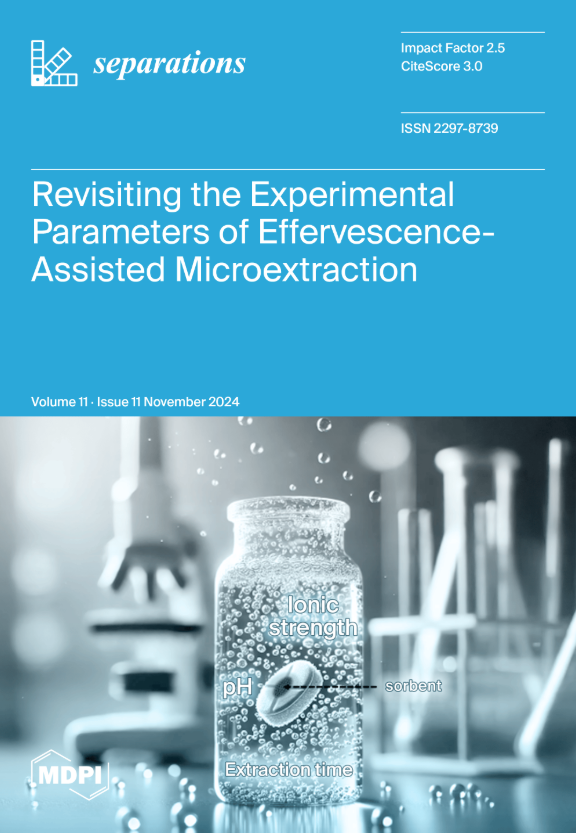黑藻及其渣对废水中铜离子的吸附性能及机理研究
IF 2.7
4区 工程技术
Q3 CHEMISTRY, ANALYTICAL
引用次数: 0
摘要
褐藻具有易得、成本低、操作方便、吸附量大等优点,作为一种生物吸附剂用于水中重金属的修复得到了广泛的研究。本研究以生褐藻和褐藻渣作为低成本、可再生的吸附材料,对废水中的铜进行了有效去除。考察了温度、载样量、吸附时间、初始金属离子浓度和pH对金属离子吸附效率的影响。研究了生海藻和海藻渣对Cu (II)的吸附热力学和动力学,以确定最大去除效率和容量。利用SEM、FTIR、EDS等对吸附铜前后的海藻和海藻渣进行表征,并结合热力学研究,证实了吸附过程中涉及的离子交换机制。在最优条件下,黑螺旋藻和海藻渣的去除率分别为75%和71%,10 min内对黑螺旋藻和海藻渣的吸附量分别达到12.15 mg/g和9.09 mg/g。海藻酸盐萃取过程中活性离子交换位点被部分去除,导致萃取效率略有下降。生海藻和海藻渣对金属离子的去除效率比较表明,黑藻渣作为生物吸附剂是可行的,在工业吸附过程中具有应用潜力。研究结果提供了一种新的方法来提升海藻生物量的生物炼制概念。本文章由计算机程序翻译,如有差异,请以英文原文为准。
Adsorption Properties and Mechanism of Copper Ions from Wastewater by Lessonia nigrescens and Lessonia nigrescens Residue
Given the advantages of readily availability, low cost, convenient operation, and large adsorption capacity, brown seaweed has been studied extensively as a biosorbent for heavy metal remediation from aqueous media. Herein, raw Lessonia nigrescens and brown seaweed residue, a waste product from the manufacturing of alginate from L. nigrescens, were employed as low-cost and renewable adsorption materials for effective copper removal in wastewater streams. The influences of temperature, sample loadings, adsorption time, initial metal ion concentrations, and pH on the efficiency of the metal ions adsorption process were investigated. The thermodynamics and kinetics of Cu (II) adsorption for both the raw seaweed and seaweed residue were studied in order to determine the maximum removal efficiency and capacity. The characterization of the seaweed and seaweed residue before and after copper adsorption with SEM, FTIR, EDS, etc., coupled with the thermodynamics study, confirmed the ion exchange mechanism involved in the adsorption process. Under optimal conditions, the removal efficiencies were 75% and 71% for L. nigrescens and seaweed residue, respectively, and the adsorption capacities can reach 12.15 mg/g and 9.09 mg/g within 10 min for L. nigrescens and seaweed residue, respectively. The slight reduction in removal efficiency was because the active ion exchange sites were partially removed during the alginate extraction. The comparable metal ion removal efficiency between raw seaweed and seaweed residue suggesting the L. nigrescens residue is viable as bio-adsorbent and potential for industrial applications in adsorption process. The results provided a novel way to upgrade seaweed biomass in a biorefinery concept.
求助全文
通过发布文献求助,成功后即可免费获取论文全文。
去求助
来源期刊

Separations
Chemistry-Analytical Chemistry
CiteScore
3.00
自引率
15.40%
发文量
342
审稿时长
12 weeks
期刊介绍:
Separations (formerly Chromatography, ISSN 2227-9075, CODEN: CHROBV) provides an advanced forum for separation and purification science and technology in all areas of chemical, biological and physical science. It publishes reviews, regular research papers and communications. Our aim is to encourage scientists to publish their experimental and theoretical results in as much detail as possible. There is no restriction on the length of the papers. The full experimental details must be provided so that the results can be reproduced. There are, in addition, unique features of this journal:
Manuscripts regarding research proposals and research ideas will be particularly welcomed.
Electronic files and software regarding the full details of the calculation and experimental procedure, if unable to be published in a normal way, can be deposited as supplementary material.
Manuscripts concerning summaries and surveys on research cooperation and projects (that are funded by national governments) to give information for a broad field of users.
The scope of the journal includes but is not limited to:
Theory and methodology (theory of separation methods, sample preparation, instrumental and column developments, new separation methodologies, etc.)
Equipment and techniques, novel hyphenated analytical solutions (significantly extended by their combination with spectroscopic methods and in particular, mass spectrometry)
Novel analysis approaches and applications to solve analytical challenges which utilize chromatographic separations as a key step in the overall solution
Computational modelling of separations for the purpose of fundamental understanding and/or chromatographic optimization
 求助内容:
求助内容: 应助结果提醒方式:
应助结果提醒方式:


